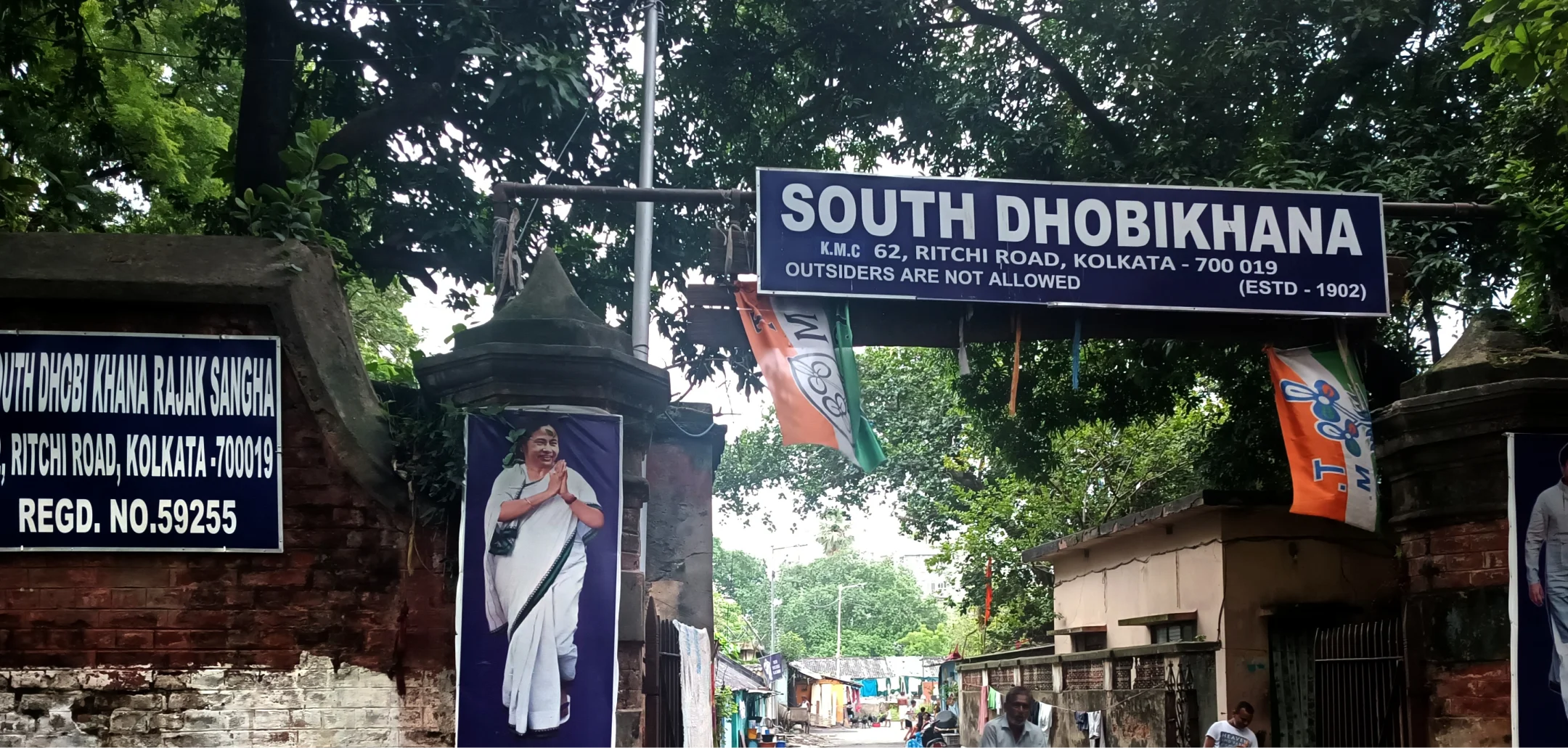The Dhobighat is a 121 year old, large, open-air laundry facility in Maddox Square, in the south of Kolkata. Established during colonial rule, the facility has played a major role in shaping the labor economy of the city by employing those involved in the washing and dyeing industry. It has turned into a social and cultural hub, of sorts, by preserving the rich heritage of communal washing. According to Sukanta Chaudhuri’s book “Kolkata: The Cultural and Intellectual Capital of Modern India,” the facilities and the workers are “[a] unique representation of the traditional way of washing clothes and preserving cultural heritage.”
Dhobis are traditionally washermen and women who work in designated facilities called Dhobighats. Clothes are generally hand wrung after washing and dried on lines before being ironed and delivered to their owners. The dyeing process on the other hand, involves separating clothes based on their color and immersing them in vats of dyed water. They are left to soak and then hung out to dry on lines.
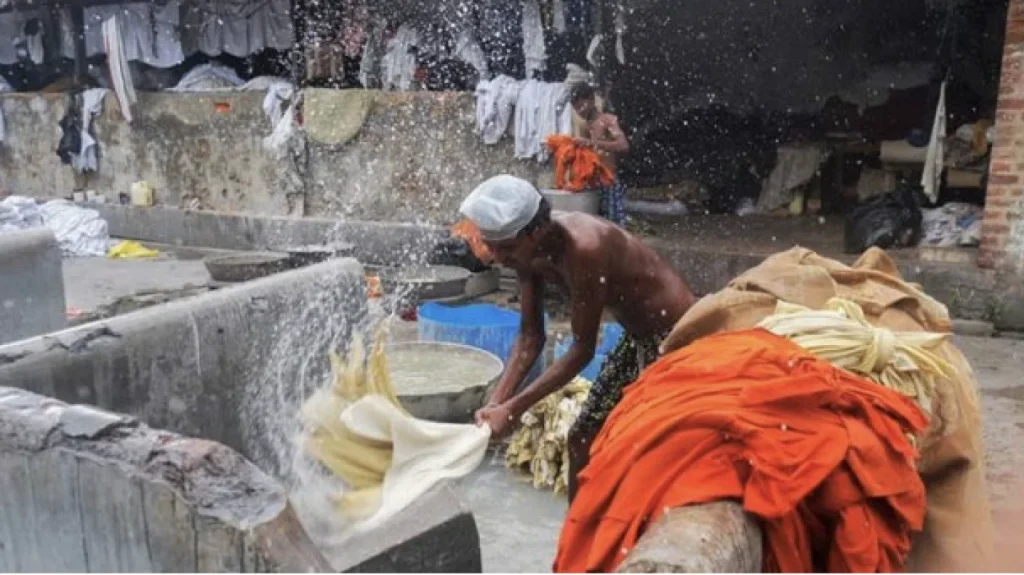
While dhobighats are known to consume less energy, the water is often polluted with chemical detergents and dyes causing severe environmental concerns. Increasing efforts to minimize pollution by using biodegradable detergents, recycled water, and treated wastewater are being made by many organizations.
Using the role of water as a vital resource and a rich component of social identity, this visual study explores ways to use this element judiciously. It also aims to shed some light on the current dyeing and laundry challenges and procedures in the dhobighats of Kolkata, as well as their labour and environmental concerns, and how to sustainably move forward.
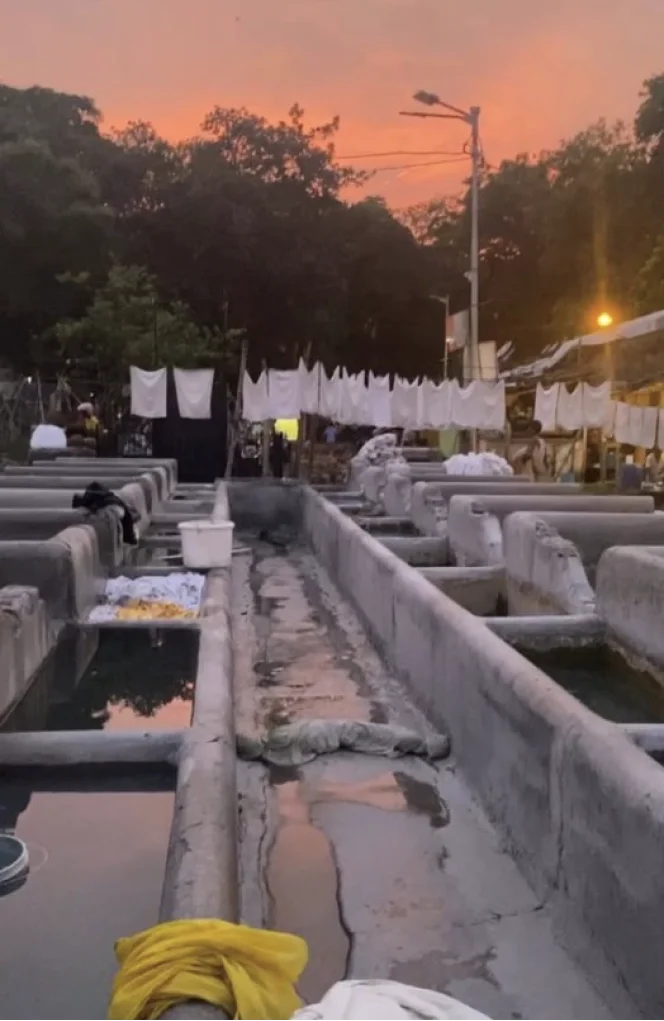
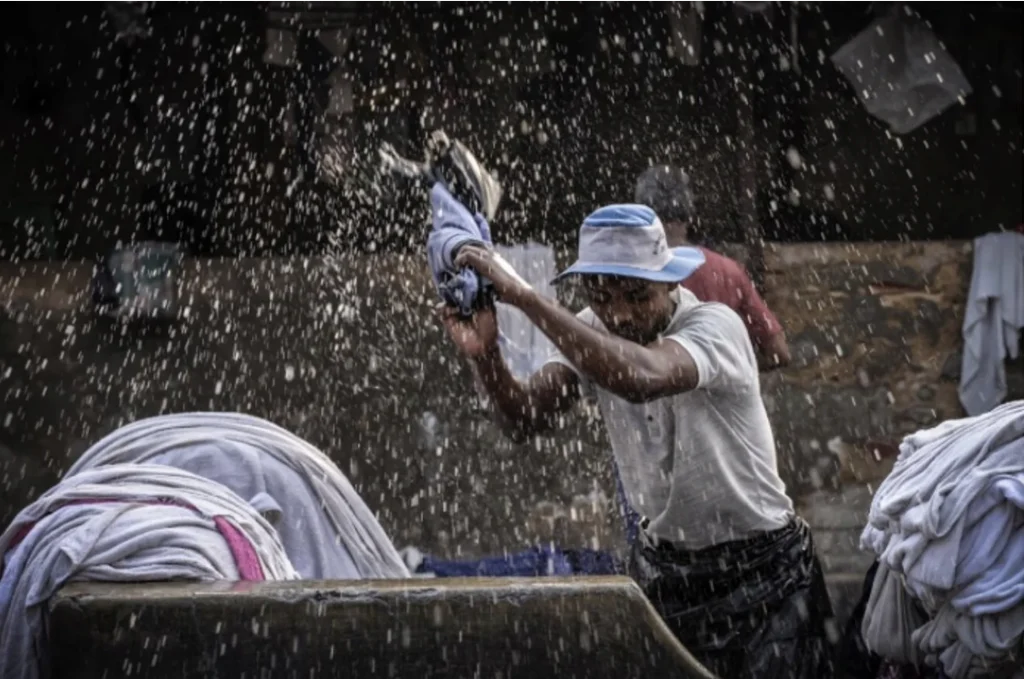
Challenges
Pollution
The absence of environmental regulatory guidelines by administrative authorities regarding dyeing and laundry chemicals have led to an abundance of cheaper quality material in the washing process. These chemicals pollute local water bodies, seep into the soil, and create water drainage issues. The dhobighats also generate large amounts of solid waste, such as lint and other textile remnants, which contribute to pollution and sanitation problems. Due to poor economic conditions, dhobis are forced to use coal or wood fire to heat water for washing, contributing to air pollution in the area.
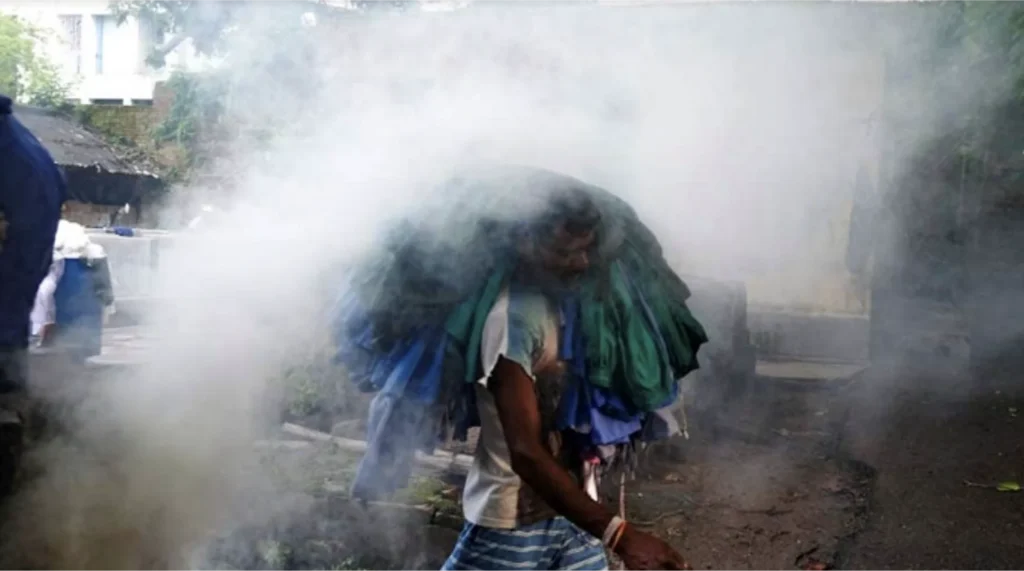
Health Hazards and Sanitation
Overcrowding, inadequate sanitation control measures and lack of protective gear for chemicals, causes skin and respiratory issues primarily among the dhobis and their families who are often present at the facility. Traditional methods of washing clothes by stomping on them with bare feet continue to raise alarms about unhygienic conditions.

Water Wastage
Dhobighats in Kolkata use nearly 78,000 liters of water every day. General physician Dr. Sayan Nath said in an interview with the Times, “An adult human drinks around 1.5 liters of water every day. So, the water used at a dhobighat can quench the thirst of 52,000 people in 10,400 households.”
The primary source of water at the dhobighat, according to some of the workers, is the Tala Tank, also a source of drinking water in the city of Kolkata. Not only does this mean that drinking water resources are being used for washing, there also is a dearth of alternative options. Councillor Sukhdeb Chakraborty says that “proposals for the installation of two borewells was made; however, the dhobis refused, saying that the iron in the underground water would make their task harder.”
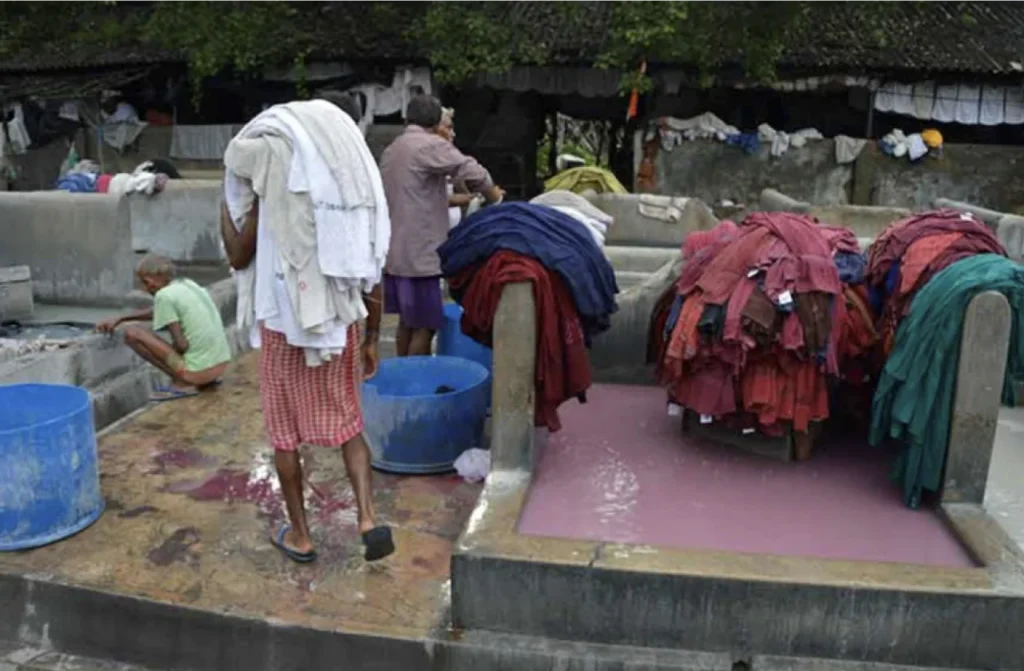
Labor Rights
The absence of an organized labor union here means that the workers are often paid a below-average wage, have little to no labor rights, no health insurance, and no paid leave.
Loss of Traditional Livelihood
Modern laundry and dyeing services use advanced technology that provides fast, efficient, and high-quality services. They also have better hygiene and sanitation standards and are more accessible to the public. Globalization has increased the stiff competition facing dhobis, endangering their livelihoods.
Having identified some of the challenges faced by the dhobighats of Kolkata, it is crucial to outline a way forward that promotes sustainable practices and improves the overall wellbeing of the community.
Institutional Support
Grants, provision of sanitation facilities, and regulatory bodies to monitor hygiene and environmental issues, can significantly alter the dhobis’ way of live. Guidelines to ensure the safety and wellbeing of the workers, and financial assistance to their families can create a renewed sense of purpose and work. The workers seem to agree that an allocation of government funds specifically to help retain their livelihood would boost morale.
Water Conservation and Waste Management
Implementing water conservation measures, such as setting up rainwater harvesting pits, recycling wastewater, and setting up freshwater tube wells to reduce the pressure on the local water supply are some of the ways local government can support the facility and its immediate environment. Diversifying water sources and reducing the reliance on the local water supply can also mitigate water pollution and promote sustainable practices.
The segregation and disposal of hazardous chemicals can improve the environmental conditions of the dhobighats, prevent pollution, and reduce the health hazards that the current process of washing and dyeing poses. Upon interviewing the workers, they spoke of the allocation of some funds towards an improved sewage system, which would also lead to reduced pollution, but the project has yet to be implemented. It is imperative that these projects see the light of day to reduce environmental costs created by processes in this industry.
Training and Awareness
Creating awareness through training and providing equipment upgrades, can improve the efficiency and quality of laundry services, and increase the income of the dhobis. Educating workers about sustainable practices, encouraging them to care about the environment and making them aware about the health hazards that their current processes of laundry and dyeing cause could impact their outlook. This in turn can potentially help change their practices if they are provided the necessary tools or resources to do so. It is so imperative to educate the dhobis, not only to help them keep up with technological and scientific advances, but also to raise awareness about their rights.
Social Upliftment
Our respondent from the South Dhobikhana also outlined that using language and terms such as the general Hindi term Bhaiya instead of referring to them as Dhopa in Bengali or Dhobi in Hindi is seen as a sign of disrespect. They also talked about how they were unable to provide their children with a better quality of life than theirs, especially in the arena of health and education, due to financial inequalities. Therefore, social reform bills and a generally respectful attitude for the workers’ life and livelihoods is an effective way to ensure they have access to a better quality of life.
This study has explored a range of relevant problems faced by the dhobighats of Kolkata and has delved into possible solutions that, if implemented, can help mitigate the major issues associated with the current laundry and dyeing processes while also retaining its cultural significance. It is crucial to consider the trade-off between scientific advances and the preservation of cultural practices when implementing solutions. The history and heritage of the city are intertwined with the dhobighat. Preserving the dhobighat sustainably is crucial as it provides employment and economic opportunities to a community long ignored, while also fostering a sense of cultural identity. By striking a balance between modernization and heritage preservation, we can ensure the continued relevance and viability of the South Dhobighat.
References
- Oldest Dhobi Khana of India is still operational in Kolkata getbengal.com › details › oldest-dhobi-kha… – Accessed on 07/01/2023 at 3:34 p.m.
- Photos: Kolkata’s original laundry service, the colonial-era …hindustantimes.com › photos › india-news – Accessed on 09/01/2023 at 4:21 p.m.
- Oldest Dhobi Khana of India is still opeational in Kolkata – Accessed on 12/01/2023 at 6:32 a.m.
- Dhobi Ghat – In pictures: Kolkata’s Ritchie Road dhobikhana telegraphindia› places › cid – Accessed on 12/01/2023 at 6:35 a.m.
- Did You Know Kolkata Has Its Own Dhobighat? – Accessed on 15/01/2023 at 6:07 p.m.
- Kolkata News – Times of India– Accessed on 23/01/2023 at 7:09 p.m.
- Dhobi Ghat Daily life Photo Story by Dibyendu Chakraborty – Dodh – Accessed on 25/01/2023 at 8:12 p.m.
- Oldest Dhobi Khana of India is still operational in Kolkata – Accessed on 10/01/2023 at 6:17 a.m.

